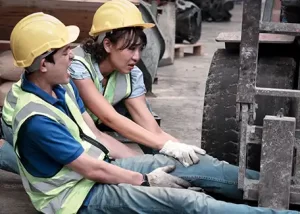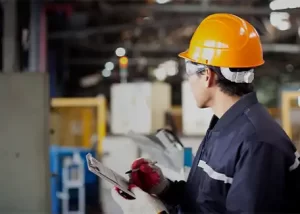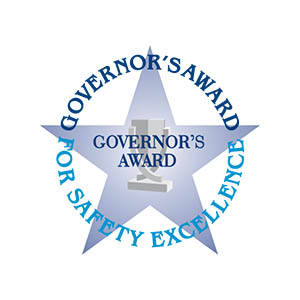By Noah Hakes, Health & Safety Technician
Construction and industrial sites are full of hazards that can lead to serious injury or even death. Among the most common, yet most dangerous, are struck-by and caught-in/between incidents.
Struck-by events happen when someone is injured by a falling, flying, swinging, or rolling object. The Occupational Safety and Health Administration (OSHA) defines a struck-by incident as “injuries produced by forcible contact or impact between the injured person and an object or piece of equipment.”
 Similar to struck-by hazards, caught-in/between incidents arise when the injury results from the person being crushed between objects, such as being trapped in a cave-in or pulled into machinery. OSHA identifies caught-in/between hazards as “injuries resulting from a person being squeezed, caught, crushed, pinched, or compressed between two or more object, or between parts of an object.”
Similar to struck-by hazards, caught-in/between incidents arise when the injury results from the person being crushed between objects, such as being trapped in a cave-in or pulled into machinery. OSHA identifies caught-in/between hazards as “injuries resulting from a person being squeezed, caught, crushed, pinched, or compressed between two or more object, or between parts of an object.”
While struck-by hazards in construction can look like caught-in/between incidents, you should evaluate the event to determine if the impact of the object alone caused the injury. If so, OSHA classifies it as a struck-by event.
Sadly, struck-by incidents are one of the top causes of construction-related deaths. In fact, most struck-by fatalities – almost 75% – involve heavy equipment, such as cranes or trucks. Additionally, according to the OSHA website, 25% of “struck-by vehicle” deaths involve construction workers – more than any other occupation.
Although all employees have the right to a safe and healthy workplace, it is the employer’s responsibility to create and promote a safety-first culture. By following these best practices, companies can reduce risk and create a safer work environment for employees.
 Conduct Regular Safety Training
Conduct Regular Safety Training
Ensure all workers receive regular safety training that covers the hazards associated with confined spaces, as well as heavy equipment and vehicles, and best practices. Workers should also be trained on the proper use of personal protective equipment (PPE) and how to respond in case of an emergency.
Create Safe Operating Procedures
Struck-by and caught-in/between incidents can be prevented with the proper safety measures in place. Establish and enforce safe work procedures. Provide adequate supervision to ensure workers’ safety. Make certain workers operate only the equipment on which they have been properly trained and are qualified to use.
Regular Equipment Maintenance
Regular equipment maintenance is crucial in preventing struck-by and caught-in/between incidents. Equipment should be inspected and maintained regularly to ensure it is in good working condition. Any defects or issues should be addressed immediately to prevent accidents.
Keep the Worksite Clean and Organized
A clean and organized worksite helps to prevent struck-by and caught-in/between incidents. Train workers how to properly store tools and equipment. Encourage them to keep the work area clean and free of debris.
Conduct Regular Safety Audits
 Regular safety audits should be conducted to identify potential hazards and areas for improvement. Audits can be performed by either an internal safety team or an outside consultant such as RETTEW. Use the results to address identified issues and improve overall safety on the worksite.
Regular safety audits should be conducted to identify potential hazards and areas for improvement. Audits can be performed by either an internal safety team or an outside consultant such as RETTEW. Use the results to address identified issues and improve overall safety on the worksite.
Preventing struck-by and caught-in/between incidents requires a combination of training, safe work practices, and ongoing maintenance and inspection of equipment. In the accompanying Toolbox Talk below, we identify common struck-by and caught-in/between hazards and discuss ways workers can prevent these types of incidents.
Does your company need confined space or OSHA construction outreach training? RETTEW offers a variety of courses and services, like construction safety oversight and high-risk work program consultation, to ensure you and your staff are prepared. Contact us to learn more about RETTEW’s comprehensive and compliant safety training programs and consultations.
Additional Offerings
Safety training and consulting are only some of RETTEW’s 600-plus services. Our safety team works hand in hand with engineers, scientists, project managers, and other technical experts at places such as manufacturing facilities, drill pads, and commercial construction sites. We are well respected for our work in a diverse number of industries and are known for ensuring workers and equipment remain safe, which keeps your projects on track and your bottom line growing.
